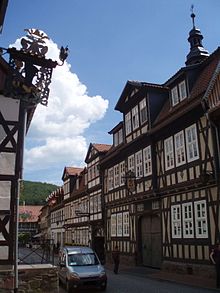Wilhelm Reiffenstein
Wilhelm Reiffenstein or von Reifenstein (* around 1482 in Bommersheim ; † around May 9, 1538 in Frankfurt am Main ) was a German humanist , rentmaster and later chancellor of Count Botho zu Stolberg and friend of Philipp Melanchthon and Martin Luther , whose brother-in-law he was .
Life
He is the son of Königsteiner Schultheissen Wilhelm Curio Reiffenstein and Elisabeth Schäffner from Bommersheim. In 1502, after completing his humanistic training, he entered the service of the Count's House of Stolberg and in 1507 [1508] was appointed Count's rent master of the two Harz counties of Stolberg (Harz) and Wernigerode . He later became a count's chancellor and was the chief administrative officer of the ruling Count Botho zu Stolberg until his death in 1538. Reiffenstein prepared the introduction of the Reformation in the Stolberg rulers and had a relatively large circle of friends, including several humanists. In his spare time he was occupied with classical works as well as ancient coins and art. He is considered a numismatist and was u. a. Asked by Melanchthon for advice in 1522 when he wanted to convert the coin denominations given in the Bible into the then valid coin values and their purchasing power.
One of the surviving letters from Martin Luther to Wilhelm Reiffenstein in Stolberg is the one from September 4, 1528 from Wittenberg.
On June 30, 1532, Emperor Charles V confirmed him in Regensburg, the chosen humanist coat of arms , the Greek singer and poet Arion of Lesbos sitting naked with a harp on a dolphin. Wilhelm Reiffenstein himself designed and drawn the corresponding antique sketch.
In 1536 he and other representatives of the city of Leipzig , including Hieronymus Lotter , acquired the Seigerhütte and the hammer mill below Ludwigsstadt .
Wilhelm Reiffenstein died on a trip to Frankfurt am Main around May 9, 1538.
The extensive property that Wilhelm Reiffenstein owned in Eselgasse in the city of Stolberg (Harz) was demolished in the first half of the 18th century. At the same place in what is now Rittergasse 7, the Graflich-Stolberg-Stolberg orphanage was built in 1717, the building of which is still present today as a representative half-timbered building in the cityscape.
family
At the age of about 35, in the summer or autumn of 1514, he married Barbara, born Meme or Mehme, who came from a middle-class family in Hettstedt and was the daughter of Hans Meme / Mehme. A sister of hers took Martin Luther's brother, Jacob Luther, as a husband. Barbara Reiffenstein was still alive in March 1575.
Wilhelm Reifenstein left three sons:
- Wilhelm (Curio) Reiffenstein (* around 1515; † 1579) lived in Wernigerode , where he granted refuge to Philipp von Melanchthon in 1547 after the battle of Mühlberg ,
- Albrecht Reiffenstein († after 1575), entered the service of Duke Albert of Bavaria in Ingolstadt
- Johann Wilhelm Reiffenstein (* around 1520; † March 19, 1575), disputed in 1536 at the University of Wittenberg , entered the service of Duke Johann Wilhelm of Saxony
literature
- Eduard Jacobs : The Reiffenstein family of humanists. In: Quarterly magazine for culture and literature of the Renaissance. 2 (1887), pp. 71-96.
- Eduard Jacobs: Luther's table companion Joh. Wilhelm Reiffenstein. In: Journal of the Association for Church History in the Province of Saxony. 3 (1906) 1, pp. 48-67.
- Ulf Sauter: In Martin Luther's footsteps in Stolberg / Harz. Personalities from the family and business environment of Luther in Stolberg / Harz. Insights into the development of the Reformation. Stolberg / Harz, self-published, 2016.
Web links
Individual evidence
- ^ Wolfgang Metzger, Veit Probst: Philipp Melanchthon and Wilhelm Reiffenstein. In: Daphnis 27 (1998)
- ^ Digitized from the Rörer Collection
- ^ Wolfgang Metzger, Veit Probst: Philipp Melanchthon and Wilhelm Reiffenstein. In: Daphnis 27 (1998).
- ↑ Ulf Sauter: In Martin Luther's footsteps in Stolberg / Harz. Personalities from the family and business environment of Luther in Stolberg / Harz. Insights into the development of the Reformation. Stolberg / Harz, Selbstverlag, 2016, p. 38 and p. 42.
| personal data | |
|---|---|
| SURNAME | Reiffenstein, Wilhelm |
| ALTERNATIVE NAMES | Reiffenstein, Wilhelm von; Reifenstein, Wilhelm |
| BRIEF DESCRIPTION | German humanist |
| DATE OF BIRTH | around 1482 |
| PLACE OF BIRTH | Bommersheim |
| DATE OF DEATH | May 1538 |
| Place of death | Frankfurt am Main |
